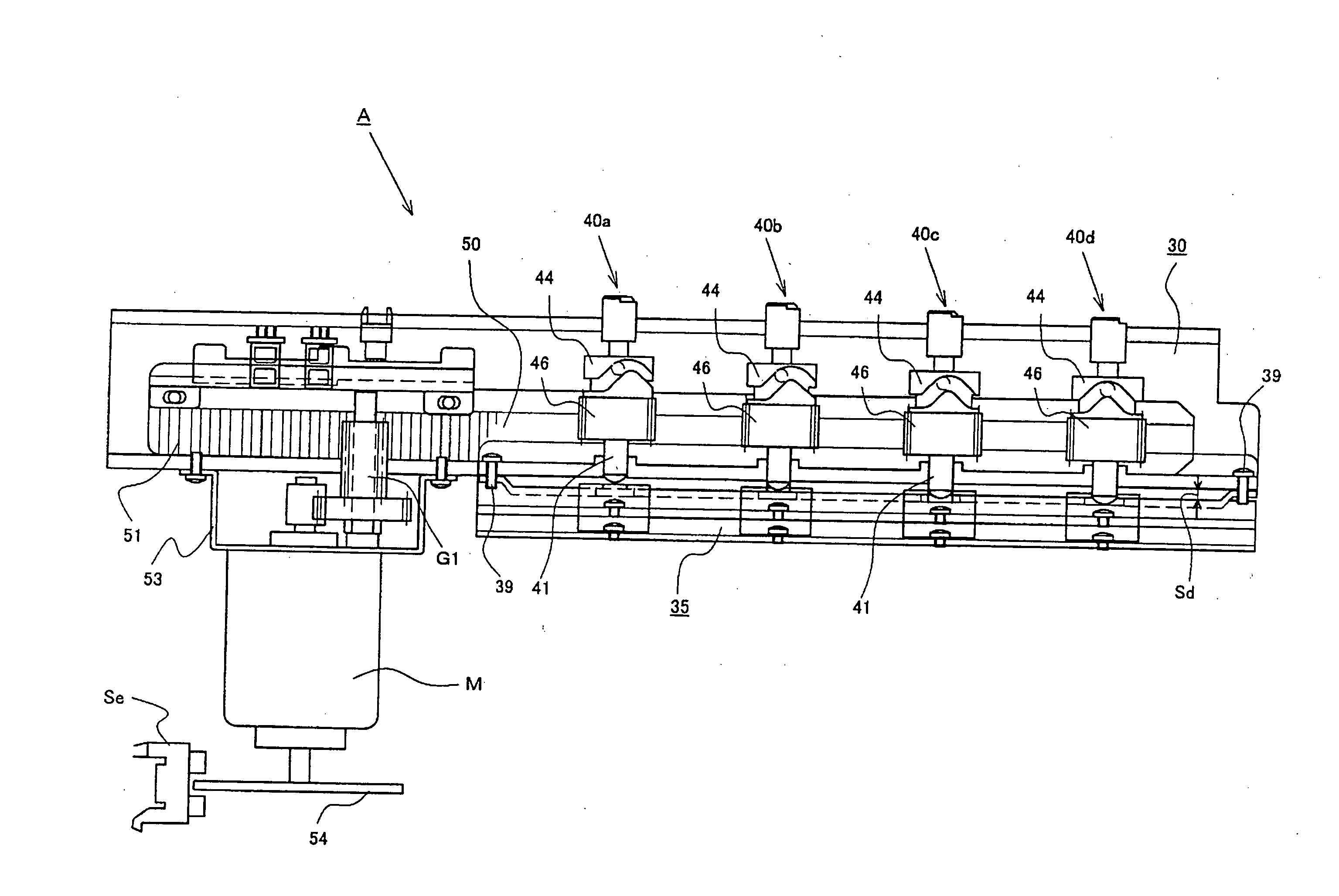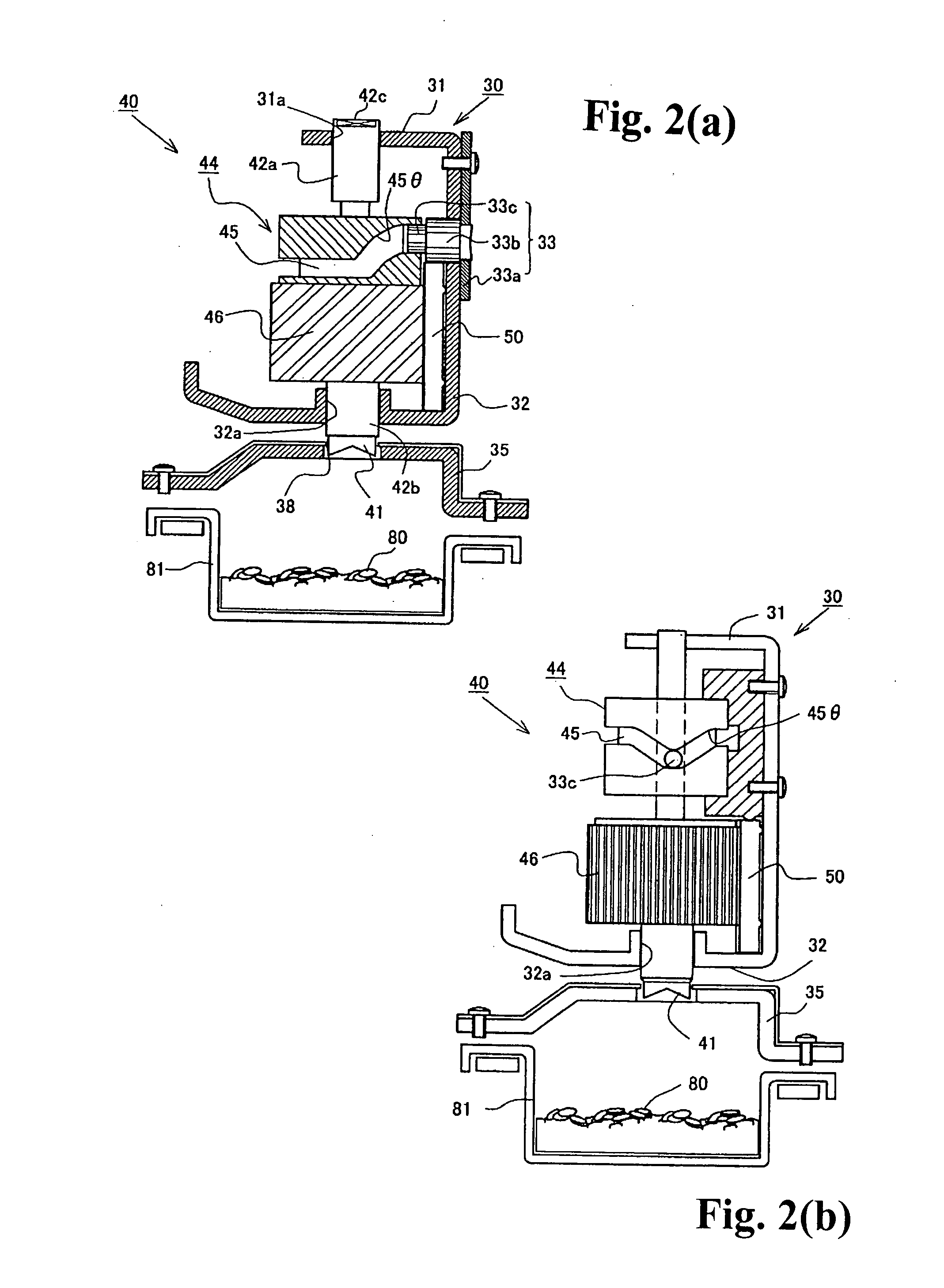Sheet hole punching apparatus and sheet hole punching method
a hole punching apparatus and hole punching technology, applied in the direction of electrographic process, manufacturing tools, instruments, etc., can solve the problems of excessive load on the drive motor, mechanical failure, and high load on the hole punching member
- Summary
- Abstract
- Description
- Claims
- Application Information
AI Technical Summary
Benefits of technology
Problems solved by technology
Method used
Image
Examples
first embodiment
of the Hole-punching Device
[0055]The following will explain the hole-punching device A shown in FIG. 1. The hole-punching device A is composed of a base frame (hereinafter referred to as the upper frame) 30 having a length dimension that corresponds to the sheet S that is to be punched with holes; a lower frame (hereinafter referred to as the die plate) 35 forming a space Sd with the upper frame 30 for setting the sheet S; punch members 40 installed in the upper frame 30; and blade bearing holes 38 disposed in the lower frame 35. The punch members 40 are formed into ordinary cylindrical shapes; a hole-punching blade 41 is disposed on each of the leading ends of the punch members 40. These punch members 40 are disposed at predetermined standard (standard for filing holes) position on the upper frame 30. There can be two, three or even four of these punch members 40. Shown in the drawing are a first punch member 40a; a second punch member 40b; a third punch member 40c; and a fourth pu...
second embodiment
of the Hole-punching Device
[0086]A different embodiment of the device shown in FIG. 1 will now be explained with reference to FIGS. 9(a) and 9(b) and 10(a), 10(b) and 10(c). As shown in FIG. 10(a), a cylindrical cam 66 is fastened to base frame 30. A lead pin 65 that engages a cam groove 67 of the cylindrical cam 66 is disposed at the punch member side. Configurations that are the same as those shown in FIG. 1 have the same symbols. Explanations of those members will be omitted.
[0087]The upper frame 30 and the lower frame 35 have the same structure as those shown in FIG. 1; both are integrally joined to form a unit. A drive motor M and drive shaft 60 that is connected to this drive motor M are disposed on the upper frame 30, as shown in FIG. 10(a). The same upper guide 31 and lower guide 32 as described above are equipped on the upper frame 30. The punch members 40 are slidably supported on the guide holes 31a and 32a of the upper and lower guides 31 and 32. The punch members 40 are...
third embodiment
of the Hole-punching Device
[0094]The following will now explain a third embodiment shown in FIG. 11 that differs from the first and second embodiments. The configuration of the punch members 40 is the same as that described in relation to the second embodiment, so the same symbols will be used but an explanation thereof will be omitted. FIG. 11 shows each punch member 40 moving upward and downward with a predetermined stroke by the reciprocating movement of a sliding cam 82, instead of the drive cam (eccentric cam) 61. A V-shaped groove cam 83 is formed in the sliding cam 82 connected to the drive motor M, not shown. This V-shaped groove cam 83 is equipped with an oblique cam surface 83a inclined to a predetermined angle in the hole-punching direction. A cam follower pin 83p that engages the V-shaped groove cam 83 is implanted in a cap member 84 mated to the punch member 40. The cap member 84 is pivotably supported to rotate on the top end of the punch member 40. Other configuration...
PUM
| Property | Measurement | Unit |
|---|---|---|
| Thickness | aaaaa | aaaaa |
| Force | aaaaa | aaaaa |
| Speed | aaaaa | aaaaa |
Abstract
Description
Claims
Application Information
 Login to View More
Login to View More - R&D
- Intellectual Property
- Life Sciences
- Materials
- Tech Scout
- Unparalleled Data Quality
- Higher Quality Content
- 60% Fewer Hallucinations
Browse by: Latest US Patents, China's latest patents, Technical Efficacy Thesaurus, Application Domain, Technology Topic, Popular Technical Reports.
© 2025 PatSnap. All rights reserved.Legal|Privacy policy|Modern Slavery Act Transparency Statement|Sitemap|About US| Contact US: help@patsnap.com



